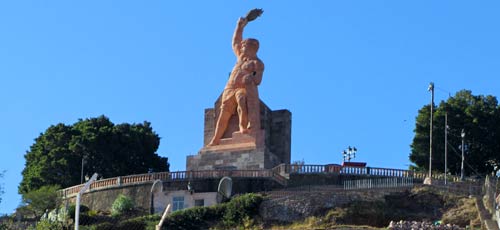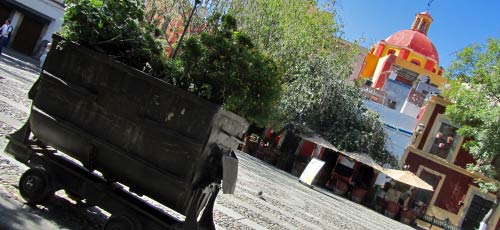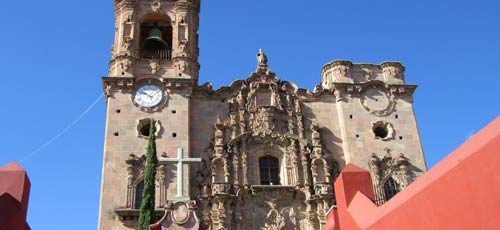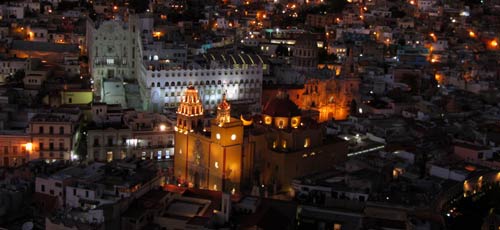GuanajuatoMexicoCity.com
The Best Guide to Guanajuato
Guanajuato in 2 Days and
Suggested Two Day Itinerary and Tour
Guanajuato makes for a fantastic destination as part of a tour of central Mexico.
The city exudes charm and charisma by boasting an extensive history, interesting tourist attractions and a great nightlife.
A packed two-day tour of Guanajuato is enough time to visit all of the major tourist sights and gain a good appreciation for the city.
This guide will indicate what is possible in a stay of 2 days and provide a suggested two-day tour of Guanajuato.
Brief Overview of the 2 Day Itinerary
Day 1 – Exploration of central Guanajuato – Main attractions include, the Alhóndiga de Granaditas, the Alley of the Kiss and Diego Rivera House-Museum and the mighty Basilica.
Day 2 – Sights around Guanajuato – The Templo La Valenciana, the La Valenciana mine, the Mummy Museum or the Cristo Rey Statue. In the evning the sunset should be watched from the the El Pipila viewpoint.

Colorful Guanajuato
In-depth 2 Day Tour of Guanajuato
The first day of the tour explores the main sights of Guanajuato, which are close to the city centre. Guanajuato is a colourful maze of narrow streets crossed by tunnels and the best approach to discovering the city is to simply get lost in it.
Around every corner is either a decorative church or a vividly painted row of houses and the city is a joy to explore.

The statue of El Pipila the hero of the region
Main tourist attractions which should not be missed include:
• The magnificent Guanajuato Basilica.
• The romantic Alley of Kisses, the setting for a classic Mexican tragic love story.
• The pretty “Plaza San Roque” and “Jardin Reforma”..
• The Mercado Hidalgo Market, a place to watch daily Mexican life.
• The imposing Alhondiga de Ganaditas, which captured during the Mexican independence and was the first victory.
• The birth place Diego Rivera House-Museum .

The Jardin Reforma
The first night should be spent in the popular “Jardin Union”. This small square is the central focus for all evening and nightlife, with fine restaurants and lively bars. In the bandstand, students perform while Mariachi bands sing for tips and the whole area has an enjoyable atmosphere, which is infectious among visitors.
Day 2 of the Two Day Tour of Guanajuato
Guanajuato is surrounded by many interesting day trips and excursions, and the second day is spent visiting two of the three popular excursions.
The three locations to visit are the village of La Valenciana, the Mummy Museum or the statue of Christ The King. The trip to “Cristo Rey” takes the most time and involves the most traveling, while the Mummy Museum is not for the squeamish. All of these trips need either a taxi or the use of public transport.

The Templo Valencia
La Valenciana offers the most variety for visitors, as the town was the location of the largest silver mine in the region.
The wealth from the silver veins funded the ornate but incomplete “Templo La Valenciana”, which is regarded as the best example of Mexican Churrigueresque style architecture.
Close to the church is the mine, where the silver was extracted and the complex has been restored to how it would have appeared during the 18th century.

The mummy museum is very creepy
The Mummy Museum is disturbing and creepy, but is loved by the Mexicans who are drawn to a macabre fascination of viewing 150-year-old mummified bodies.
The bodies were exhumed from the city’s graves, due to freak mummifying conditions of the region and the exhibits range from men and women through to children and babies. The whole place is ghoulish and certainly not suitable for children, but it’s Guanajuato’s most popular tourist attraction.

The Cristo Rey Statue
The statue of Christ the King stands atop the highest hill of the state and is a popular pilgrimage destination, as the site marks the geographical centre of Mexico.
From the summit there are wonderful views and beneath the grand statue of Christ there is a uniquely styled chapel. The journey up the summit takes around 1 hour, but can take considerable longer if there are many pilgrims.

The Basilica at night
For the evening of the second day head up to the El Pipila viewpoint and watch the sunset over Guanajuato. The viewpoint is connected to the city by the funicular and the statue dedicated to the local hero, El Pipila.
Guanajuato Mexico Tourist Guide Navigation
|
| ||||||
|
| ||||||
|
| ||||||
|
| ||||||
|
|
|
| ||||||
|
| ||||||
|
| ||||||
|
| ||||||
|
|















